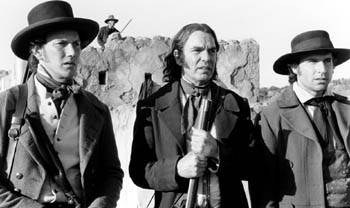![[Metroactive Movies]](/movies/gifs/movies468.gif)
[ Movies Index | Show Times | Silicon Valley | Metroactive Home | Archives ]

Photograph by Van Redin Fight Club: Patrick Wilson (left), Billy Bob Thornton (center) and Jason Patric contemplate the future site of the Alamo Dome. Death and Texas 'The Alamo' gives a revised, often accurate, version of the famed battle--John Wayne would have hated it THE ROCK upon which Texas was founded turns out to be pure papier-mâché; the accepted version of the legend of the Alamo is about as substantial as the story that this shrine's basement once contained Pee-Wee Herman's bicycle. John Lee Hancock's The Alamo makes a valiant effort to revise the tale of the 1836 stand of 180-odd irregulars and volunteers who died against a Mexican army many times their number. Still, as Jeff Long's superb book Duel of Eagles demonstrates (and among Hancock and co-screenwriters Leslie Boehm and Stephen Gaghan, someone seems to have read Long), this new version of The Alamo is about 70 percent fact--a startlingly high level, really. The film makes the case for Antonio López de Santa Anna's expedition against land-grabbing rebels in Mexican territory. Check the scene of a pair of Tejaños summing up the situation: "Santa Anna just wants to take over Mexico; these [Yankee] desgraciados want to take over the world." Saying that, Santa Anna functions as a delightful villain. Anyone who doesn't love a general will relish the way actor Emilio Echevarria basks in the fuss and the feathers, the scarlet tunic and gold frogs. The focus is not on the impressively surly, drunken Sam Houston, played by Dennis Quaid, (who was born in Houston, incidentally), or on Patrick Wilson's milquetoasty William Travis (who receives the most substantial whitewashing), or even on Jason Patric's fever-struck Bowie (interpreted as the kind of squabbler who gets a knife named after him). The film is at its best whenever it gives us the former Congressman David Crockett, come to Texas in hopes of making a home for himself. As David (he doesn't like "Davy"), Billy Bob Thornton has never been better. He interprets Crockett as everything an American ought to be: democratic, humble, musical, reluctant to fight until the fight's inevitable. Thornton's pleasure in the part is infectious. It's not often in these darker films about the West that characters look like they have a zest for living. The Alamo posits that Crockett--a genial lightweight--was cornered into writing a heroic ending to his life with his own blood. The funny thing is that the movie steers close enough to the real Alamo debacle that an audience will feel a little lost. This epic has a personality, a downbeat personality. The old-movie exposition and the cast of anti-heroes will be baffling to anyone who expects connect-the-dot plots, quick brush strokes, white wings and forked tails. The movie is shy about mentioning the pro-slavery forces behind Texas statehood, and once again the siege is told as a story of a sacrifice that bought the Texas armies some time. Hancock goes along with this fiction (in an upbeat coda at San Jacincto), yet it's apparent to even the noncombatants in the audience that the decaying, blasted Alamo could have been circumvented or starved out. On the whole, Hancock has gone more in the direction of Anthony Mann than Jerry Bruckheimer. The Alamo is a movie that neither John Wayne nor Cormack McCarthy would approve of--and that's something.
The Alamo (PG-13; 137 min.), directed by John Lee Hancock, written by Leslie Bohem, Stephen Gaghan and Hancock, photographed by Dean Semler, and starring Billy Bob Thornton, Dennis Quaid and Patrick Wilson, opens Friday valleywide.
Send a letter to the editor about this story to letters@metronews.com. [ Silicon Valley | Metroactive Home | Archives ]
|
From the April 7-14, 2004 issue of Metro, Silicon Valley's Weekly Newspaper.
Copyright © Metro Publishing Inc. Metroactive is affiliated with the Boulevards Network.
For more information about the San Jose/Silicon Valley area, visit sanjose.com.